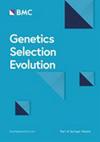Microbiome composition as a potential predictor of longevity in rabbits
IF 3.6
1区 农林科学
Q1 AGRICULTURE, DAIRY & ANIMAL SCIENCE
引用次数: 0
Abstract
Longevity and resilience are two fundamental traits for more sustainable livestock production. These traits are closely related, as resilient animals tend to have longer lifespans. An interesting criterion for increasing longevity in rabbit could be based on the information provided by its gut microbiome. The gut microbiome is essential for regulating health and plays crucial roles in the development of the immune system. The aim of this research was to investigate if animals with different longevities have different microbial profiles. We sequenced the 16S rRNA gene from soft faeces from 95 does. First, we compared two maternal rabbit lines with different longevities; a standard longevity maternal line (A) and a maternal line (LP) that was founded based on longevity criteria: females with a minimum of 25 parities with an average prolificacy per parity of 9 or more. Second, we compared the gut microbiota of two groups of animals from line LP with different longevities: females that died/were culled with two parities or less (LLP) and females with more than 15 parities (HLP). Differences in alpha and beta diversity were observed between lines A and LP, and a partial least square discriminant analysis (PLS-DA) showed a high prediction accuracy (> 91%) of classification of animals to line A versus LP (146 amplicon sequence variants (ASV)). The PLS-DA also showed a high prediction accuracy (> 94%) to classify animals to the LLP and HLP groups (53 ASV). Interestingly, some of the most important taxa identified in the PLS-DA were common to both comparisons (Akkermansia, Christensenellaceae R-7, Uncultured Eubacteriaceae, among others) and have been reported to be related to resilience and longevity. Our results indicate that the first parity gut microbiome profile differs between the two rabbit maternal lines (A and LP) and, to a lesser extent, between animals of line LP with different longevities (LLP and HLP). Several genera were able to discriminate animals from the two lines and animals with different longevities, which shows that the gut microbiome could be used as a predictive factor for longevity, or as a selection criterion for these traits.微生物组构成是兔子长寿的潜在预测因子
长寿和恢复力是实现更可持续畜牧业生产的两个基本特性。这两个特性密切相关,因为恢复力强的动物往往寿命更长。提高兔子寿命的一个有趣标准可能是基于其肠道微生物组提供的信息。肠道微生物组对调节健康至关重要,并在免疫系统的发育中发挥关键作用。这项研究的目的是调查不同寿命的动物是否具有不同的微生物特征。我们对 95 只母兔的软粪进行了 16S rRNA 基因测序。首先,我们比较了两个不同长寿的母兔品系:一个是标准长寿母系(A),另一个是根据长寿标准建立的母系(LP):母兔至少有 25 个产仔数,每个产仔数平均多产 9 只或更多。其次,我们比较了来自 LP 品系的两组不同长寿动物的肠道微生物群:两胎或两胎以下死亡或被淘汰的雌性动物(LLP)和 15 胎以上的雌性动物(HLP)。在 A 系和 LP 系之间观察到了α和β多样性的差异,偏最小二乘法判别分析(PLS-DA)显示,将动物归入 A 系和 LP 系(146 个扩增子序列变异(ASV))的预测准确率很高(> 91%)。PLS-DA 还显示,将动物归入 LLP 和 HLP 组(53 个 ASV)的预测准确率很高(> 94%)。有趣的是,在 PLS-DA 中发现的一些最重要的类群在两次比较中都是共同的(Akkermansia、Christensenellaceae R-7、未培养的 Eubacteriaceae 等),而且据报道这些类群与恢复力和寿命有关。我们的研究结果表明,两个兔母本品系(A 和 LP)的第一产仔期肠道微生物组特征不同,而不同长寿品系 LP 的动物(LLP 和 HLP)的第一产仔期肠道微生物组特征也不同。一些菌属能够区分两个品系的动物和不同长寿率的动物,这表明肠道微生物组可用作长寿的预测因素,或用作这些性状的选择标准。
本文章由计算机程序翻译,如有差异,请以英文原文为准。
求助全文
约1分钟内获得全文
求助全文
来源期刊

Genetics Selection Evolution
生物-奶制品与动物科学
CiteScore
6.50
自引率
9.80%
发文量
74
审稿时长
1 months
期刊介绍:
Genetics Selection Evolution invites basic, applied and methodological content that will aid the current understanding and the utilization of genetic variability in domestic animal species. Although the focus is on domestic animal species, research on other species is invited if it contributes to the understanding of the use of genetic variability in domestic animals. Genetics Selection Evolution publishes results from all levels of study, from the gene to the quantitative trait, from the individual to the population, the breed or the species. Contributions concerning both the biological approach, from molecular genetics to quantitative genetics, as well as the mathematical approach, from population genetics to statistics, are welcome. Specific areas of interest include but are not limited to: gene and QTL identification, mapping and characterization, analysis of new phenotypes, high-throughput SNP data analysis, functional genomics, cytogenetics, genetic diversity of populations and breeds, genetic evaluation, applied and experimental selection, genomic selection, selection efficiency, and statistical methodology for the genetic analysis of phenotypes with quantitative and mixed inheritance.
 求助内容:
求助内容: 应助结果提醒方式:
应助结果提醒方式:


